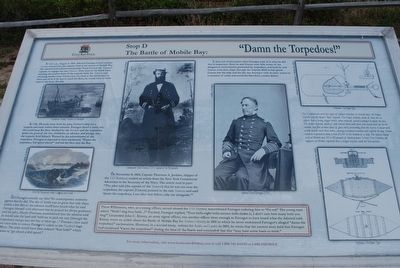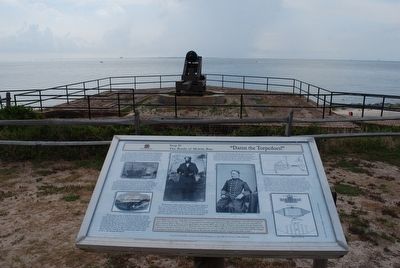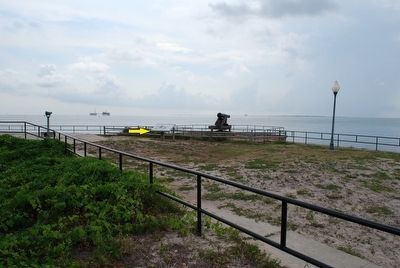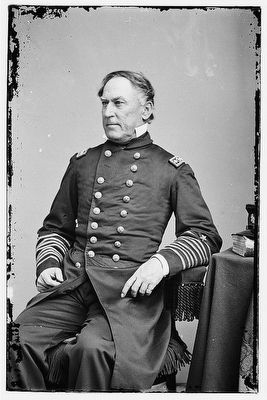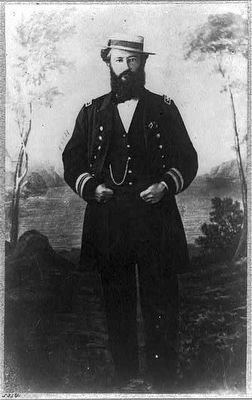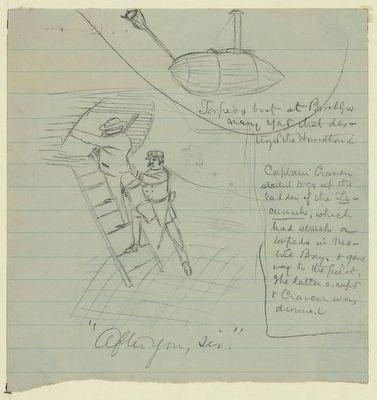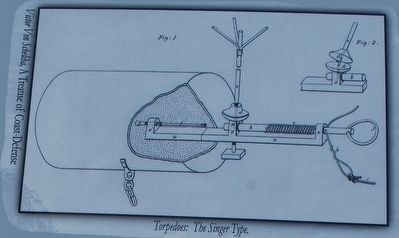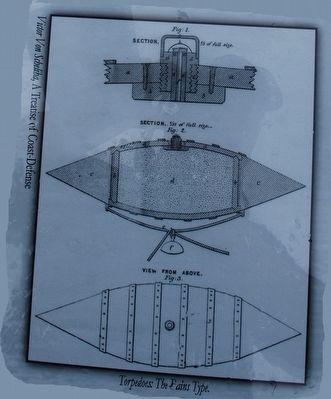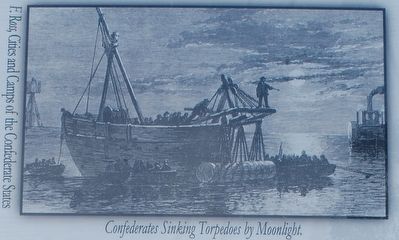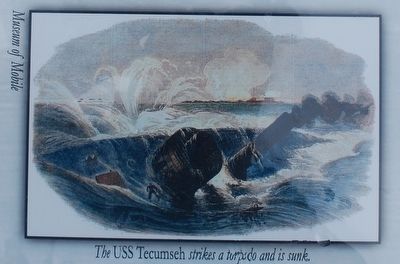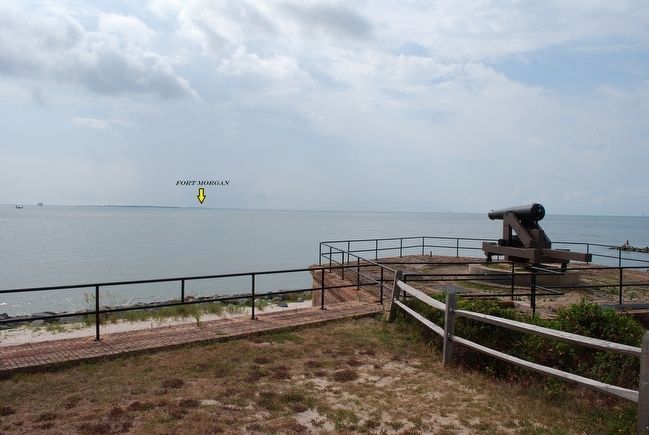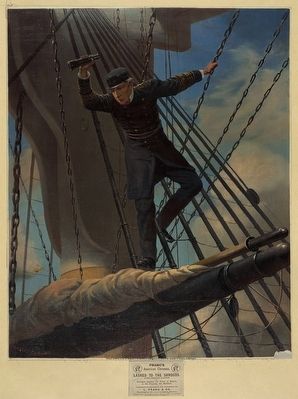Dauphin Island in Mobile County, Alabama — The American South (East South Central)
“Damn the Torpedoes!”
The Battle of Mobile Bay:
— Stop D —
At 7:25 a.m., August 5, 1864, Admiral Farragut’s lead monitor Tecumseh steered into the torpedo field at the mouth of Mobile Bay. The admiral had ordered Commander Tunis Craven, the Tecumseh’s captain, to engage the ram Tennessee. Then west of the black buoy marking the eastern limit of the torpedo field, the Tennessee was steaming further west. Craven was too close to the black buoy to steer east of it; if he was to catch the Ram, he would have to move west of the buoy. He did.
At 7:40, 100 yards away from his prey, Craven’s ship hit a torpedo and sank within three minutes. Farragut faced a crisis, too. He could keep his fleet, blocked by the Brooklyn and the torpedoes, under the guns of the fort, withdraw, or advance and plunge into the torpedo field himself. Warned by his subordinates of the torpedoes, Farragut is reported to have exclaimed, “Damn the torpedoes, full speed ahead!” and led his fleet into the Bay.
Did Farragut actually say this? No contemporary authority proves that he did. The din of battle was so great that only those within a few feet of the admiral could have heard what he said. Farragut himself said afterward that he prayed for divine guidance, and his pilot, Martin Freeman, remembered that the admiral said he would take the lead and “told me to pick my way [through the torpedoes] and go into the bay or blow up…” Freeman then used his voice tube to convey Farragut’s orders to the Hartford’s deck officer. The pilot would have then ordered “four bells!” which means to “go ahead at full speed.”
On November 8, 1864, Captain Thornton A. Jenkins, skipper of the USS Richmond, mailed an article from the New York Commercial Advertiser to the Secretary of the Navy. The article read in part: “The pilot told [the captain of the Tecumseh] that he was too near the torpedoes; the captain [Craven] pointed to the ram Tennessee and said ‘damn the torpedoes, I am after that fellow; take me alongside.”
It does not much matter what Farragut said. It is what he did that is important. Both he and Craven were fully aware of the dangerous uncertainties presented by torpedoes, and both he and Craven took their ships through the torpedo field at full speed. Craven lost his ship and his life, but Farragut took decisive action a moment of crisis and saved his fleet from certain defeat.
The Confederates used two types of contact torpedoes in Mobile Bay: the Singer torpedo and the Rains “keg” torpedo. The Singer torpedo made of iron, tin, or copper, had a spring trigger which, when released, caused a plunger to ignite the fuse. The Rains torpedo, made of oak barrels lined with pitch and coated with tar on the outside, had five or more fuses of glass tubes protruding from the barrel. Contact with a ship would crush those tubes, causing a chemical reaction and explode the keg. Either could be expected to blow a hole 8’x10’ in the bottom of a ship. The typical charge used at Mobile was 35 to 50 pounds of black powder. Victor Von Scheliha, an engineer at Mobile, reported that a Singer torpedo sank the Tecumseh.
(sidebar)
Thom Williamson, who, as a young officer, served aboard the USS Hartford, remembered Farragut ordering him to “Go on!” The young man asked, “Shall I ring four bells…?” Excited, Farragut replied, “Four bells-eight bells-sixteen bells-damn it, I don’t care how many bells you ring!” Lieutenant John C. Kinney, an army signal officer, was another officer close enough to Farragut to have heard what the Admiral said. Kinney wrote an article about the Battle of Mobile Bay for Scribner’s Monthly in 1881 in which he never mentioned Farragut’s alleged “damn the torpedoes!” exclamation. However, in a second essay, written for Battles and Leaders in 1884, he wrote that the current story held that Farragut had exclaimed “damn the torpedoes!” during the heat of the battle and concluded that this “may have some basis in truth.”
Erected by Civil War Trail Battle for Mobile Bay. (Marker Number Stop D.)
Topics. This historical marker is listed in these topic lists: Forts and Castles • War, US Civil. A significant historical month for this entry is November 1931.
Location. 30° 14.888′ N, 88° 4.501′ W. Marker is on Dauphin Island, Alabama, in Mobile County. Marker can be reached from Bienville Boulevard east of Albatross Street, on the right when traveling east. Located atop the east wall of Fort Gaines, overlooking Mobile Bay. Touch for map. Marker is at or near this postal address: 51 Bienville Blvd, Dauphin Island AL 36528, United States of America. Touch for directions.
Other nearby markers. At least 8 other markers are within walking distance of this marker. Anchor From U.S.S. Hartford (within shouting distance of this marker); "Save Your Garrison." (within shouting distance of this marker); Storm Clouds Gather (about 300 feet away, measured in a direct line); "To Be Blown To Kingdom Come" (about 300 feet away); British Occupation of Dauphin Island (about 500 feet away); Fort Gaines (about 500 feet away); 19th Century Shipwreck (about 600 feet away); Energy from the Sands of Time (about 700 feet away). Touch for a list and map of all markers in Dauphin Island.
More about this marker. There is an identical marker at Fort Morgan with
the exception that it is labeled as Stop C, instead of stop D, as this marker is labeled.
Also see . . .
1. Historic Fort Gaines. Website homepage (Submitted on May 5, 2022, by Larry Gertner of New York, New York.)
2. Battle for Mobile Bay. Civil War Trail website entry (Submitted on August 16, 2015.)
Credits. This page was last revised on May 5, 2022. It was originally submitted on August 15, 2015, by Brandon Fletcher of Chattanooga, Tennessee. This page has been viewed 984 times since then and 52 times this year. Photos: 1, 2, 3, 4, 5, 6, 7, 8, 9, 10, 11, 12. submitted on August 15, 2015, by Brandon Fletcher of Chattanooga, Tennessee. • Bernard Fisher was the editor who published this page.
